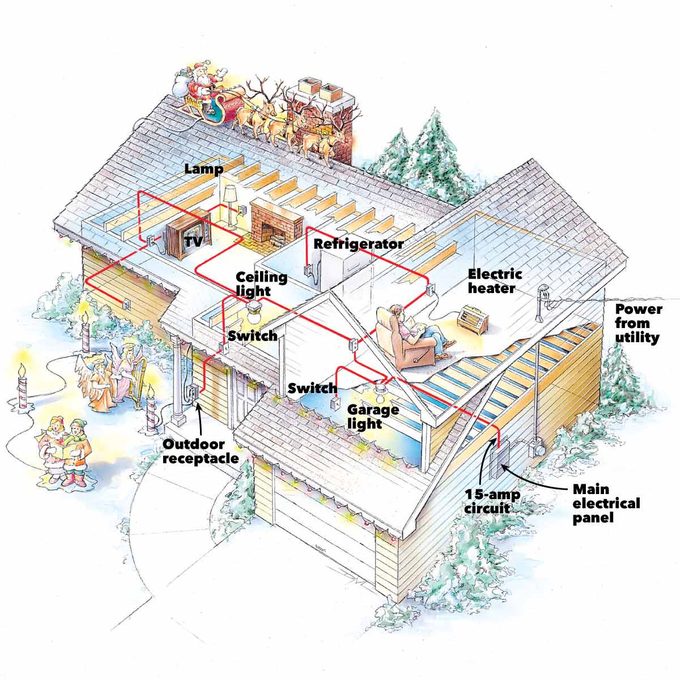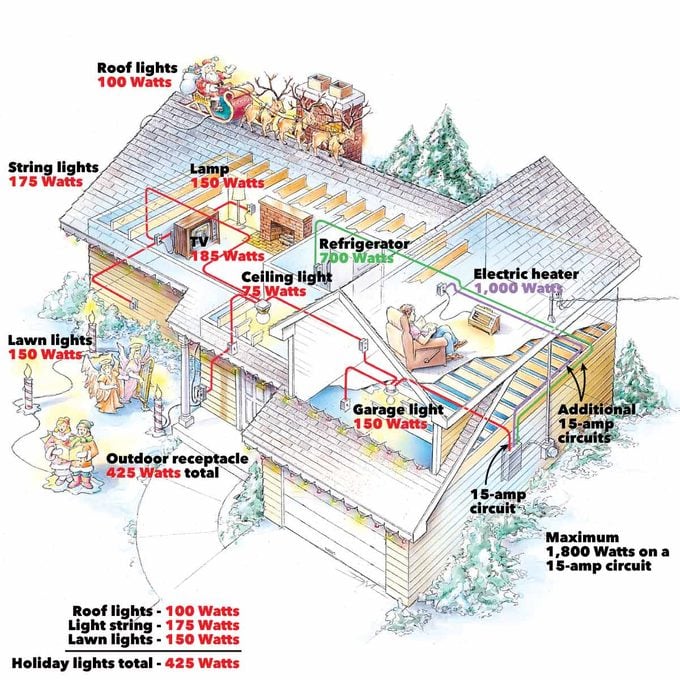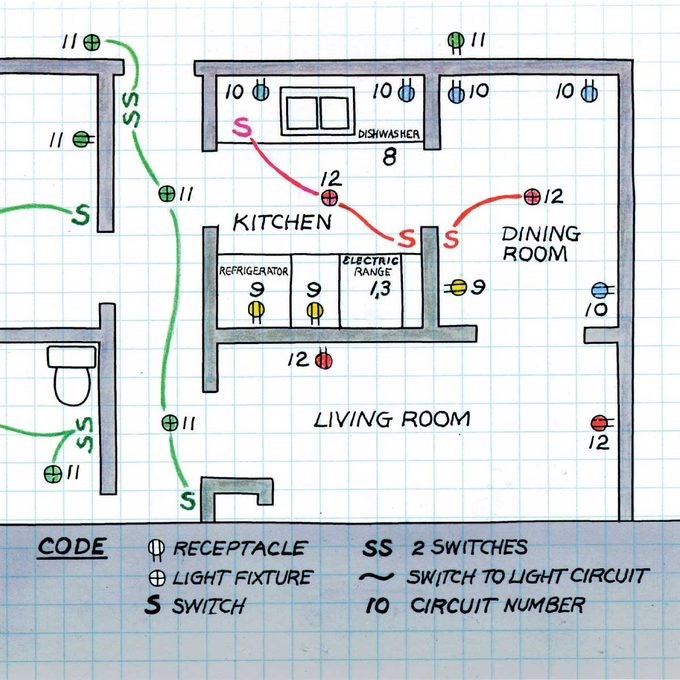Preventing Electrical Overloads
Excursion breakers, overloads and your electrical system.
Understanding Electrical Overloads
Every December, the neighbor across the street lights upwardly the cake with an elaborate vacation light display. 4-foot plastic angels stand in ranks, three-ft. candles dot the landscape, elves pop out from behind plastic snow figures, and Santa in his loaded sleigh skims across the roof with a cluster of reindeer.
But every twelvemonth dozens of outdoor light displays like this unexpectedly get out. You might have plugged in a small electrical heater and turned information technology on to warm your feet. Or switched on a pilus dryer. Or dropped a snack into the toaster. It'southward not simply the outdoor display that goes out, merely perhaps most of the master flooring lights as well. The TV in the family room quits. The clock in the kitchen stops. And subsequently an electrician tells you that the refrigerator stopped running besides.
The problem? An overloaded circuit. The power needed by the outdoor lights added to the load from the refrigerator, the heater and any other devices connected to the aforementioned circuit, and all of them running at once exceeded the chapters of the electrical wiring (Fig. A).
Rest assured that an overload in a properly installed electrical organisation wouldn't burn your house downward. An "overcurrent protective device" at the chief panel will automatically close off the power before damage occurs. In most cases, the device volition exist a circuit billow that trips open up. In older systems a fuse volition "blow" (burn out). Merely finding a solution tin can be a hassle.
In this commodity we'll tell yous how to sort out the circuits in your electrical system and avoid overloads. You'll not only avoid occasional blackouts but besides avert chronic overloading when you expand your system to include additional outlets, light fixtures or holiday lights.
Effigy A: Circuit With an Overload
An electric circuit with too many electrical devices turned on can exceed the circuit limit. Circuit breakers or fuses will automatically shut off the circuit at the chief panel.

Circuit logic
The nerve heart of your electrical system is the main panel, ordinarily a gray metallic box near the size of a cookie sheet, that typically sits in some obscure spot in a utility room, the garage or the basement. Iii large wires from the utility visitor feed the main panel. Although you might spot the wires outside if they're overhead, they'll be encased in conduit within for safety, because they comprise about unlimited electrical ability.
Circuit breakers (or fuses) in your principal console limit the power to a level that your wiring system can safely handle and funnel that ability through co-operative circuits, the wires that run to various parts of your business firm. If you turn on too much stuff and the ability demand on whatever one circuit exceeds the limits of the circuit breaker (or fuse), the breaker snaps open up and shuts down the unabridged circuit, serving you lot notice that you have an overload or some other trouble.
At offset glance, the spider spider web of cables that spreads out from your master panel might expect impossibly complex. Fortunately, the National Electric Code (NEC) imposes a kind of excursion logic that simplifies the organization. The circuits in the main panel are roughly divided into 2 types—dedicated and general purpose. These are the most common NEC violations DIYers make.
Dedicated circuits include those serving a single large-describe apparatus like the furnace, range, built-in microwave and garbage disposer (come across chart).
Other dedicated circuits are for special uses like small-scale kitchen appliances, laundry equipment and the bathroom. Considering of the potentially large electrical ability draw on these circuits, the NEC restricts the employ of them (although small appliance circuits can serve receptacles in an next dining room; see Fig. C).
Most of these should exist labeled at the main console, although they often aren't. And don't be surprised if you lot find other outlets on these circuits in older and remodeled homes. Over the years the NEC has gradually increased the number of dedicated circuits, every bit electrical appliance utilise has grown.
General-purpose circuits, on the other hand, serve multiple outlets such as lighting and nigh of the residual of the receptacles (outlets) in your dwelling. Normally you tin can tap into one of these circuits when you need actress power or want to add another outlet. But not e'er. If you're adding a receptacle for a loftier-power use device such every bit an air conditioner or electrical heater, you might have to run an entirely new excursion.
Figure B: Correcting an Overload
Add up all the electrical loads on the excursion. If the load exceeds the limit allowed by the National Electric Code, redistribute the load to other general purpose circuits or run new circuits to the largest loads.

Common Dedicated Circuits
Appliance Ability Required (watts)
- Electric Range 5,000 (240 volts)
- Electric Dryer six,000 (240 volts)
- Space Heater ane,000 and up
- Dress Washer 1,150
- Furnace (blower) 800
- Microwave 700–1,400
- Refrigerator (not required) 700
- Freezer (not required) 700
- Dishwasher 1,400
- Fundamental Vacuum 800
- Whirlpool/Jacuzzi 1,000 and up
- Garbage Disposer 600–i,200
- Kitchen Countertop (two circuits): Toaster 900
- Java maker 800
- Toaster oven 1,400
- Bathroom: Blow dryer 300–1,200
Solutions to Overloads
The immediate solution to an overload is simple: Shift some plug-in devices from the overloaded excursion to another general-purpose circuit. So flip the circuit billow dorsum on or supervene upon the fuse and turn stuff back on.
In exercise, even so, it isn't so easy to know that you've plant a skilful, long-term solution. First you have to locate outlets on another general-purpose excursion. Then you take to find a convenient manner to reach it. Resist the temptation to solve the trouble with an extension string. Extension cords are for short-term use. They're not to exist used equally permanent wiring or fastened into place.
To trace your full general-purpose circuits, begin with the labels on the main panel. They're supposed to give you some idea where the circuits run. They're usually accurate for dedicated circuits, but they're often too vague to aid y'all pinpoint general-purpose outlets. Chances are, you lot'll accept to map out these circuits yourself.
To trace a circuit, plough off its breaker at the main panel (or unscrew the fuse), then go through your habitation testing outlets—flipping on lite switches and plugged-in devices and plugging in a exam light into open receptacles.
Test both the upper and lower receptacle of standard duplex receptacles, because they're sometimes wired to different circuits. And make sure switched receptacles are "on" earlier testing them. Check outdoor lights and receptacles also. Outlets that don't work are connected to the circuit that's off. Write your results down, or put them on a simple flooring-plan diagram so you won't forget or skip locations (Fig. C).
Repeat for other circuits until you know what's what. Don't be surprised if you find general-purpose outlets on defended circuits. Information technology's non unusual to find the family unit room on the same circuit as the refrigerator (Fig. A). (And remember to reset the clocks when you're washed!)
One time you've mapped out the general-purpose circuits (even better—all your circuits), sharpen your pencil and add up the existing electric loads on them. Fig. B shows the loads of the diverse lights and devices that were originally connected to one of the circuits institute in Fig. A.
Light bulbs usually accept their wattage stamped on them. Motors are often rated in amperes or "amps" (amps x 120 volts = watts), a figure you lot'll find on a plate on the motor or elsewhere on the device. TVs and other electronics usually take a watt rating on a backside label. Then figure the additional load yous want to add together, in this example the holiday lights.
Devices temporarily plugged in, such as a vacuum cleaner or temporarily used portable electric heater, don't count. Devices (for example, vacation lights or an often used electric heater) with long-term uses do count.
A excursion is overloaded if: A. The total load exceeds 1,800 watts for a fifteen-amp circuit. (120 volts ten 15 amps = 1,800 watts.) Wait for the amp rating of the circuit in tiny numbers on the circuit breaker switch or fuse to determine how many outlets you lot can have on a 15-amp circuit. For a 20-amp circuit, the load limit is ii,400 watts. B. On a multiple-outlet excursion, you find any appliance or equipment rated at more than half the circuit rating, 900 watts for a 15-amp excursion. (These large-depict appliances should take dedicated circuits.)
Upon checking, we institute that the case circuit in Fig. A exceeded both the 1,800-watt limit for a fifteen-amp circuit and the 900-watt limit for any one device. The best solution to solve this overload situation is to run a defended circuit to the biggest load. In practise, to avoid high installation costs, professional electricians run new circuits to the appliances they tin can attain near hands.
In our case, a professional electrician would run two new circuits, one to the refrigerator (700 watts) and another to the outlet treatment the heater (i,000-plus watts). Run across Fig. B.
Practical advice: Don't load your circuits to the maximum (figure nearly fourscore percent). Otherwise, you're more likely to have hassles with overloads when yous temporarily plug in high-draw devices such as a vacuum cleaner (800 to ane,100 watts).
Figure C: Map Your Circuits
Sketch your floor programme and draw in your electrical outlets, labeling them according to their circuit number from the primary panel. Circuits 11 and 12 are full general-purpose circuits.

Adding a New Outlet
Later on calculating the loads on your general-purpose circuits, you can redistribute the loads (plug-in devices) so no unmarried circuit has more than than 1,800 watts. This isn't always user-friendly, however. You'll often accept to add a new circuit, equally we did in our example, or install a new outlet to go the power where you desire it.
To add a new outlet, observe a circuit with sufficient capacity (following rules A and B above) that has a convenient junction box to tap into. Y'all can sometimes find easy access to lights or switch boxes in an unfinished basement. Otherwise, expect to the attic. The junction boxes in near attics (assuming your attic is accessible) are usually cached under insulation, and then yous'll probably take to rake the insulation aside. (Vesture a dust mask, goggles and long sleeves if y'all do this!) Expect for junction boxes near the access pigsty kickoff, or over ceiling light fixtures in rooms beneath. (Think: The power must come directly to the light box, not from a switch.)
CAUTION : Electrical boxes might contain wires from several circuits. Test the wires with a voltage tester before touching them to make sure the ability is off.
Practical advice: If the wiring in a box looks complicated, find a unlike box or phone call in an electrician to make the connections.
Brand sure the existing box is large plenty to conform the additional new cable. Wires packed into as well small a box tin can overheat.
Practical advice: It'southward often easier and faster to run an entirely new excursion from the main panel, rather than notice and tap into an existing excursion. If you install the new outlet yourself and run the new cable dorsum to the main panel, an electrician will make the hook-upwards inside the console.
Caution : Working inside the chief panel is dangerous. Let a pro exercise it.
Safe Electrical Practices Pay Off
Always utilize for an electric permit from your local building inspections section when you undertake an electrical project. The permit not just ensures that your piece of work will be inspected for proper technique and safety simply also that you've properly analyzed your home'southward circuitry and are following a sound program.
Source: https://www.familyhandyman.com/article/preventing-electrical-overloads/
0 Response to "Preventing Electrical Overloads"
Post a Comment